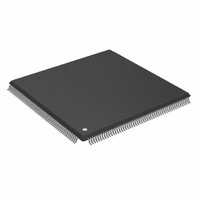ADSP-21065LKSZ-240 Analog Devices Inc, ADSP-21065LKSZ-240 Datasheet - Page 11

ADSP-21065LKSZ-240
Manufacturer Part Number
ADSP-21065LKSZ-240
Description
IC DSP CONTROLLR 544KBIT 208MQFP
Manufacturer
Analog Devices Inc
Series
SHARC®r
Type
Fixed/Floating Pointr
Datasheet
1.ADSP-21065LKSZ-240.pdf
(44 pages)
Specifications of ADSP-21065LKSZ-240
Interface
Host Interface, Serial Port
Clock Rate
60MHz
Non-volatile Memory
External
On-chip Ram
64kB
Voltage - I/o
3.30V
Voltage - Core
3.30V
Operating Temperature
0°C ~ 85°C
Mounting Type
Surface Mount
Package / Case
208-MQFP, 208-PQFP
No. Of Bits
32 Bit
Frequency
60MHz
Supply Voltage
3.3V
Embedded Interface Type
HPI, Serial
No. Of I/o's
12
No. Of Mips
66
Supply Voltage Range
3.13V To 3.6V
Lead Free Status / RoHS Status
Lead free / RoHS Compliant
Other names
ADSP-21065LKSZ240
ADSP-21065LKSZ240
ADSP-21065LKSZ240
Available stocks
Company
Part Number
Manufacturer
Quantity
Price
Company:
Part Number:
ADSP-21065LKSZ-240
Manufacturer:
MICRON
Quantity:
5 000
Company:
Part Number:
ADSP-21065LKSZ-240
Manufacturer:
ADI31
Quantity:
239
Company:
Part Number:
ADSP-21065LKSZ-240
Manufacturer:
Analog Devices Inc
Quantity:
10 000
Part Number:
ADSP-21065LKSZ-240
Manufacturer:
ADI/亚德诺
Quantity:
20 000
The BTMS, BTCK, BTRST and BTDI signals are provided so
that the test access port can also be used for board-level testing.
When the connector is not being used for emulation, place
jumpers between the Bxxx pins and the xxx pins. If you are not
going to use the test access port for board testing, tie BTRST
to GND and tie or pull-up BTCK to V
be asserted after power-up (through BTRST on the connector)
or held low for proper operation of the ADSP-2106x. None of
the Bxxx pins (Pins 5, 7, 9, 11) are connected on the EZ-ICE probe.
The JTAG signals are terminated on the EZ-ICE probe as follows:
Signal
TMS
TCK
TRST*
TDI
TDO
CLKIN
EMU
*TRST is driven low until the EZ-ICE probe is turned on by the emulator at
REV. C
software start-up. After software start-up, TRST is driven high.
Termination
Driven through 22 W resistor (16 mA driver)
Driven at 10 MHz through 22 W resistor
(16 mA driver)
Driven through 22 W resistor (16 mA driver)
(pulled up by on-chip 20 kW resistor)
Driven by 22 W resistor (16 mA driver)
One TTL load, Split Termination (160/220)
One TTL load, Split Termination (160/220).
(Caution: Do not connect to CLKIN if
internal XTAL oscillator is used.)
Active Low 4.7 kW pull-up resistor, one TTL
load (open-drain output from ADSP-2106xs)
DD
. The TRST pin must
–11–
Connecting CLKIN to Pin 4 of the EZ-ICE header is optional.
The emulator only uses CLKIN when directed to perform
operations such as starting, stopping, and single-stepping two
ADSP-21065Ls in a synchronous manner. If you do not need
these operations to occur synchronously on the two processors,
simply tie Pin 4 of the EZ-ICE header to ground.
For systems which use the internal clock generator and an external
discrete crystal, do not directly connect the CLKIN pin to the
JTAG probe. This will load the oscillator circuit and possibly
cause it to fail to oscillate. Instead the JTAG probe’s CLKIN
can be driven by the XTAL pin through a high impedance buffer.
If synchronous multiprocessor operations are needed and CLKIN
is connected, clock skew between multiple ADSP-2106x
processors and the CLKIN pin on the EZ-ICE header must be
minimal. If the skew is too large, synchronous operations may
be off by one cycle between processors. For synchronous multi-
processor operation TCK, TMS, CLKIN and EMU should be
treated as critical signals in terms of skew, and should be laid
out as short as possible on your board.
If synchronous multiprocessor operations are not needed (i.e.,
CLKIN is not connected), just use appropriate parallel termina-
tion on TCK and TMS. TDI, TDO, EMU and TRST are not
critical signals in terms of skew.
For complete information on the SHARC EZ-ICE, see the
ADSP-21000 Family JTAG EZ-ICE User’s Guide and Reference.
ADSP-21065L

















